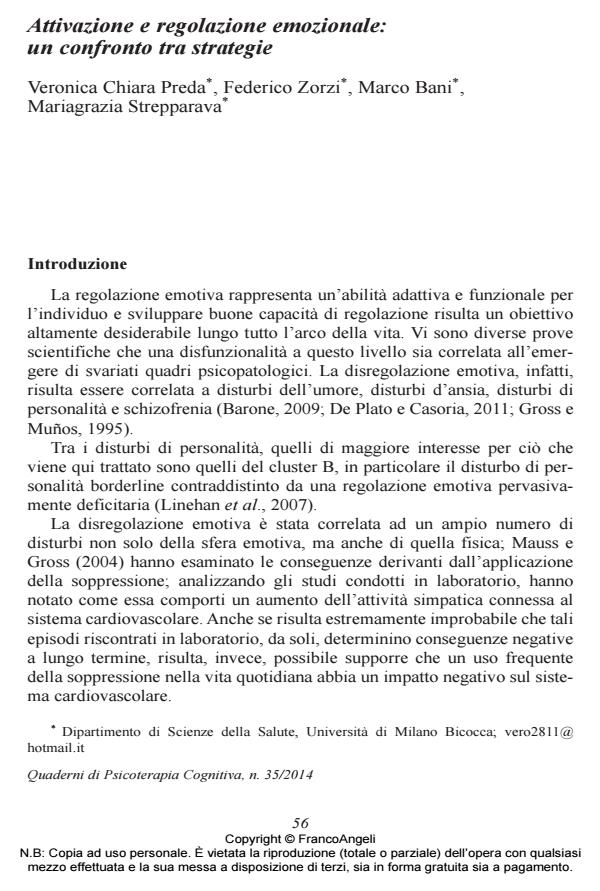Arousal and emotion regulation: a comparison among different strategies
Journal title QUADERNI DI PSICOTERAPIA COGNITIVA
Author/s Veronica Chiara Preda, Federico Zorzi, Marco Bani, Mariagrazia Strepparava
Publishing Year 2014 Issue 2014/35 Language Italian
Pages 13 P. 56-78 File size 75 KB
DOI 10.3280/QPC2014-035004
DOI is like a bar code for intellectual property: to have more infomation
click here
Below, you can see the article first page
If you want to buy this article in PDF format, you can do it, following the instructions to buy download credits

FrancoAngeli is member of Publishers International Linking Association, Inc (PILA), a not-for-profit association which run the CrossRef service enabling links to and from online scholarly content.
This study investigated emotion regulation, with the specific aim of assessing the effectiveness of three different emotional strategies (reappraisal, distraction and suppression) in modifying the intensity of perceived emotions. To this end, 80 non-clinical subjects, 40 males and 40 females, aged 20-30 years (M = 24.51 years; SD = 2.714), were randomly assigned to four groups, one for each of the three strategies under study plus a control group. Participants were shown six clips eliciting anger, sadness, disgust, fear, tenderness or amusement, self-rating their level of emotional arousal on the PANAS scale for each clip. Distraction was found to be the most effective emotion regulation strategy; compared to the control group, subjects that used distraction obtained significantly different scores on the positive affect scale in relation to the clips eliciting anger and disgust, and on the negative affect scale in relation to the clip eliciting disgust. Reappraisal and suppression did not significantly alter emotional experience.
Keywords: Emotion regulation, distraction, suppression, reappraisal, films, arousal.
- Aldao A., Nolen-Hoeksema S., Schweizer S. (2010). Emotion-regulation strategies across psychopathology: A meta-analytic review. Clinical Psychology Review, 30: 217-237. DOI: 10.1016/j.cpr.2009.11.00
- Barone L. (2009). La regolazione emotive nel ciclo della vita: la prospettiva evolutiva. In: O. Matarazzo, V.L. Zammuner, a cura di, La regolazione delle emozioni. Bologna: Il Mulino.
- Butler E.A., Lee T.L., Gross J.J. (2007). Emotion regulation and culture: Are the social consequences of emotion suppression culture-specific? Emotion, 7: 30-48. DOI: 10.1037/1528-3542.7.1.3
- De Plato G., Casoria M. (2011). Emozioni: disturbi e trattamento. In: G. De Plato, a cura di, Psicologia e psicopatologia delle emozioni. Bologna: Bononia University Press, pp. 203-308.
- Dörfel D., Lamke J.P., Hummel F., Wagner U., Erk S., Walter H. (2014). Common and differential neural networks of emotion regulation by Detachment, Reinterpretation, Distraction, and Expressive Suppression: A comparative fMRI investigation. Neuroimage. 101: 298-309. DOI: 10.1016/j.neuroimage.2014.06.05
- Fischer A.H., Rodriguez Mosquera P.M., Van Vianen A.E.M., Manstead A.S.R. (2004). Gender and culture differences in emotion. Emotion, 4: 87-94.
- Gross J.J. (1998a). Antecedent- and response-focused emotion regulation: Divergent consequences for experience, expression, and physiology. Journal of Personality and Social Psychology, 74: 224-237. DOI: 10.1037/0022-3514.74.1.22
- Gross J.J. (2002). Emotion regulation: Affective, cognitive, and social consequences. Psychophysiology, 39: 281-291. DOI: 10.1017/S004857720139319
- Gross J.J., John O.P. (2003). Individual differences in two emotion regulation processes: Implications for affect, relationships, and well-being. Journal of Personality and Social Psychology, 85: 348-362. DOI: 10.1037/0022-3514.85.2.34
- Gross J.J., Levenson R.W. (1993). Emotional suppression: Physiology, self-report, and expressive behavior. Journal of Personality and Social Psychology, 64: 970-986. DOI: 10.1037/0022-3514.64.6.97
- Gross J.J., Levenson R.W. (1995). Emotion elicitation using films. Cognition and Emotion, 9 (1): 87-108. DOI: 10.1080/0269993950840896
- Gross J.J., Levenson R.W. (1997). Hiding feelings: The acute effects of inhibiting positive and negative emotions. Journal of Abnormal Psychology, 106: 95-103. DOI: 10.1037/0021-843X.106.1.9
- Gross J.J., Muños R.F. (1995). Emotion regulation and mental health. Clinical Psychology: Science and Practice, 2: 151-164. DOI: 10.1111/j.1468-2850.1995.tb00036.
- Gross J.J. (2008). Emotional regulation. In: M. Lewis, J.M. Haviland-Jones, L.F. Barrett, editors, Handbook of emotions. New York: Guilford Press, pp. 497-512.
- Grossman M., Wood W. (1993). Sex differences in intensity of emotional experience: A social role interpretation. Journal of Personality and Social Psychology, 65: 1010-1022. DOI: 10.1037/0022-3514.65.5.101
- Hofmann S.G., Heering S., Sawyer A.T., Asnaani A. (2009). How to handle anxiety: The effects of reappraisal, acceptance, and suppression strategies on anxious arousal. Behavior Research and Therapy, 47 (5): 389-394. DOI: 10.1016/j.brat.2009.02.01
- Linehan M.M., Bohus M., Lynch T.R. (2007). Dialectical behavior therapy for pervasive emotion dysregulation. The theoretical and practical underpinnings. In: J.J. Gross, editor, Handbook of emotion regulation. New York: Guilford Press, pp. 581-605. Matsumoto D., Nakagawa S., Yoo S.H. & 37 Members of the Multinational Study of Cultural Display Rules (2008). Culture, emotion regulation, and adjustment. Journal of Personality and Social Psychology, 94 (6): 925-937. DOI: 10.1037/0022-3514.94.6.92
- Mauss I.B., Gross J.J. (2004). Emotion suppression and cardiovascular disease: Is hiding feelings bad for your heart? In: L.R Temoshok, A. Vingerhoets, I. Nyklícek, editors.
- Emotional expression and health: Advances in theory, assessment and applications. New York: Brunner-Routledge, pp. 61-81.
- Mauss I.B., Cook C.L., Cheng Y.J., Gross J.J. (2007). Individual differences in cognitive reappraisal: Experiential and physiological responses to an anger provocation. International Journal of Psychophysiology, 66: 116-124. DOI: 10.1016/j.ijpsycho.2007.03.01
- Nolen-Hoeksema S., Aldao A. (2011) Gender and age differences in emotion regulation strategies and their relationship to depressive symptoms. Personality and Individual Differences, 51: 704-708. DOI: 10.1016/j.paid.2011.06.01
- Schaefer A., Nils F., Sanchez X., Philippot P. (2010). Assessing the effectiveness of a large database of emotion-eliciting films: A new tool for emotion researchers. Cognition and Emotion, 24 (7): 1153-1172. DOI: 10.1080/0269993090327432
- Szasz P.L., Szentagotai A., Hofmann S.G. (2011). The effect of emotion regulation strategies on anger. Behaviour Research and Therapy, 49: 114-119. DOI: 10.1016/j.brat.2010.11.01
- Terracciano A., McCrae R.R., Costa Jr. P.T. (2003). Factorial and construct validity of the Italian Positive and Negative Affect Schedule (PANAS). European Journal of Psychological Assessment, 19 (2): 131-141. DOI: 10.1027//1015-5759.19.2.13
- Watson D., Clark L.A., Tellegen A. (1988). Development and validation of brief measures of positive and negative affect: The PANAS scales. Journal of Personality & Social Psychology, 54 (6): 1063-1070. DOI: 10.1037/0022-3514.54.6.106
Veronica Chiara Preda, Federico Zorzi, Marco Bani, Mariagrazia Strepparava, Attivazione e regolazione emozionale: un confronto tra strategie in "QUADERNI DI PSICOTERAPIA COGNITIVA" 35/2014, pp 56-78, DOI: 10.3280/QPC2014-035004